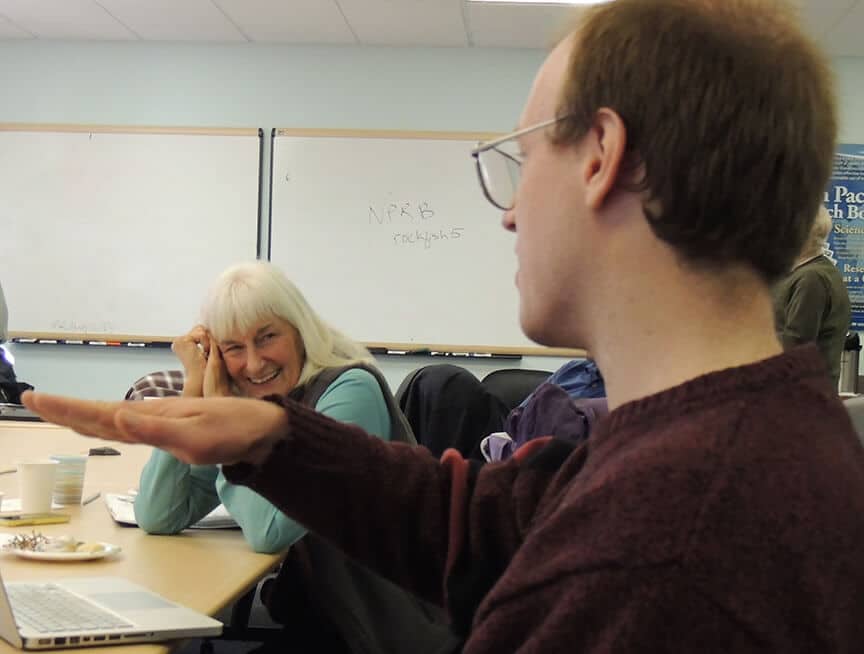Learning, Leading, Sharing
Collaboration produces the best work and the best science. CIRCAC is committed to building partnerships among citizens, agencies and industry to help develop projects and programs that meet our OPA 90 mandates. One of CIRCAC’s biggest successes is seeing projects and initiatives exceed expectations and grow to become of statewide significance, such as the following examples.

COOK INLET HARBOR SAFETY COMMITTEE

As part of the Management Team for the Cook Inlet Navigational Risk Assessment, CIRCAC was instrumental in moving that project forward, organizing, gathering funding, sponsoring forums, and soliciting expert and public input. The Risk Assessment is complete, largely because of our leadership.
The risk assessment study identified as a first risk reduction option: establish a Harbor Safety Committee to identify potential problems, develop or recommend non-regulatory mitigation measures, and evaluate the success or, if needed, reformulation of these measures with the goal of continuous improvement. Cook Inlet Harbor Safety Committee has now been established as a primary vehicle for implementing its priority recommendations. We apply this same leadership mentality to all our projects and partnerships.
ALASKA SHOREZONE PARTNERSHIP
Acquiring knowledge and sharing the beauty of Alaska’s coast through ShoreZone

CIRCAC first introduced ShoreZone to Alaska in 2009 as a pilot project. Now known as the Alaska ShoreZone Partnership, the project has grown to more than 40 partners who have mapped at least 80 percent of Alaska’s coastline.
In the process of developing an inventory of our coast’s biological and geological habitats in our ShoreZone mapping project, we created an archive of high resolution digital imagery in our areas of concern. We whittled this list of tens of thousands of photographs to create an exhibit of large format prints so that everyone can learn about the natural wonders in our stunningly beautiful coastal backyard. The result is Coastal Impressions: A Photographic Journey along Alaska’s Gulf Coast, shown in Anchorage, Juneau, Homer and Kenai. This exhibit inspired an Arctic Impressions exhibit, the Coastal and Arctic Impressions: Artists paint ShoreZone exhibit, and a digital exhibit which is planned for the Anchorage Rasmussen Museum.
COOK INLET BELUGA WHALE STUDY
Our beluga whale study results are providing some of the only information available on winter habitat and prey and will inform other Cook Inlet beluga whale life history studies and the recovery team, as well as enhance decisions by managers. Working with our partners at the Alaska Ocean Observing System, NOAA National Marine Fisheries Service, and the Fish and Wildlife Foundation, CIRCAC is contributing to efforts to disseminate beluga whale data through the Cook Inlet Beluga Whale Ecosystem Portal.
ALASKA CLEAN HARBORS
One of many CIRCAC initiatives done in partnership with the Alaska Department of Environmental Conservation is Alaska Clean Harbors. CIRCAC identified clean harbors as a priority in 2007 and created a steering committee with the Alaska Department of Environmental Conservation and a grant from ConocoPhillips.
CIRCAC MEMORIAL SCHOLARSHIPS
We hope to inspire the next generation to make protecting Cook Inlet a personal and professional goal and in 2015, we launched our first Scholarship Program to support students who have chosen to pursue environmental science or maritime studies in honor of Captain Barry Eldridge and James Carter.
PUBLIC OUTREACH
We make a concerted effort to share information through educational presentations and training, promoting best practices and advancements in oil spill response technology, peer review, participation on panels, committees, and boards, such as the ASTM, Clean Pacific, ADEC Air Quality Task Force, Pacific States/BC Task Force, Oil Spill Dispersants Work Group, and more; we organize public exhibits, issue a monthly newsletter, and maintain a robust website to share data, reports and studies.
With the fluidity of today’s Cook Inlet oil facility operations, citizen oversight is more relevant than ever, guaranteeing CIRCAC will continue to make the best possible decisions for protecting Cook Inlet’s waters and shorelines from the harmful effects of oil and hazardous spills.










